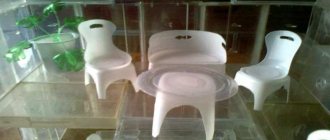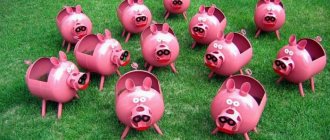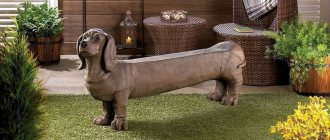Article on the topic: handmade crafts from plastic bottles.
The use of PET containers in a summer cottage
What is a plastic container? These are, first of all, polymeric material and ready-made containers. From this angle, any summer resident with a creative vision and straight hands will be able to make a lot of useful devices for the household from ordinary PET bottles, create elements of garden decor and turn empty containers into necessary things.
The main advantage of plastic containers is the lack of cost. In addition, PET is light, plastic, resistant to atmospheric influences and UV radiation, and can be easily processed. A plastic bottle filled with water can withstand enormous external pressure and can act as a heat accumulator. And most importantly: in any variation, all plastic containers have a threaded section and a lid. And this is a very important thing for any master to do, which will help fasten products if such a need arises. Let's consider several options for using plastic containers in the garden.
Storage systems
Plastic bottles are an ideal solution for creating containers. You can store office supplies, small sewing accessories or detergents in containers. Multi-level systems for small items can be easily placed in the garage or workshop, in the bathroom or in the bedroom.
Transparent organizers allow you to easily see the contents. Several identical containers can be combined into one system. For example, install it in a strong frame box, like drawers.
Organizers made from plastic containers Source vodolei-idei.livejournal.com
Plastic bottles for watering the garden
The first thing you can use ready-made PET containers for is for watering. Irrigation of a plot is generally a pressing issue for most summer residents, especially for those who receive water on a schedule or visit a suburban area only on weekends. In such a situation, useless plastic bottles will help, which will help create an irrigation system for the entire site without any financial costs. Let's consider three easy-to-implement options for creating a drip irrigation system based on plastic bottles of various capacities.
Simple root irrigation system
In order to water plants in doses and automatically, you will need:
- PET containers with a volume of 2 liters at the rate of one bottle - one plant.
- foam rubber (any scraps).
Pour water into each container to 4/5 of its volume. Insert a piece of foam rubber into the neck instead of a cork. Place the bottle under the plant so that the neck is in close proximity to the plant's root. As you empty, simply add water to the container.
Drip irrigation
For this irrigation system, the size and shape of the containers does not matter. According to reviews from summer residents: the more, the better. Bottles need to have their bottoms cut off. Use a hot awl or thin drill to make 3-5 holes in the cork, 1-2 mm in diameter. Screw the stopper tightly onto the neck.
Dig such a container vertically (neck down) near each plant and fill it with water. Such a stationary root irrigation system requires only timely filling with water.
Hanging irrigation system
In this option, whole bottles with a capacity of 2 to 5 liters should be used. depending on the reliability of the fastening system. As when creating a drip system, make several holes in the plug with a diameter of 1 mm.
Now you need to build a support. Spears should be dug at different ends of the bed, with a jumper (slat, timber) placed on top of them. Hang the filled containers, neck down, from the top bar.
To prevent water from eroding the ground, the area where water drops fall should be mulched.
The advantages of a watering system made from plastic bottles are undeniable:
- the soil is moistened directly in the root zone of the plant;
- Irrigation is carried out with water heated by the sun;
- possibility of adding fertilizers directly to water;
- variability of application.
But the most important advantage of such watering is that it does not require human presence.
Agricultural technology using PET bottles
Any container can be used to grow greens. The main thing is to ensure timely watering and avoid stagnation of water in the lower part of the container. This can be done by creating a vertical garden from plastic bottles, which will not take up much space, but will decorate your fence, balcony railing, or house wall.
Vertical garden with horizontal bottle mount
For such a structure you will need:
- PET bottles, capacity 2 -5 l;
- soft wire.
1/3 of the side of the bottle is cut out. The plug is screwed onto the neck. On the side opposite to the cutout, a mass of drainage holes is made with an awl (nail, drill).
The bottles are filled with a substrate, inside which seedlings or plant seeds are located. The improvised pot is attached to a vertical surface with soft wire. The remaining containers can be fastened one below the other or in a checkerboard pattern.
Garden made from vertically installed PET containers
This design is more complex than the previous one, but is much more efficient and is relatively autonomous. So, to create such a design you will need:
- PET bottles, volume 1-3 l.
- rubber or silicone hose ½ inch.
- a section of sewer pipe with plugs, diameter - at the discretion of the owner.
The bottles are cut approximately in half. The upper part will be used to create a vertical garden, the lower part will be used to create decorations, which will be discussed below. The top parts of the bottles are attached to each other with the neck down. A hose with holes for irrigation is laid through each vertical row. The free space is filled with earth or substrate. The upper part of the hoses is secured in the low tide using necks and caps from plastic bottles.
Water is supplied to the system from the water supply, and a section of the sewer pipe will act as a liquid storage tank. This design allows for rational use of water for drip irrigation. A vertical garden made from plastic bottles will not require any space or large financial expenses from the summer resident. You can always make a design from unnecessary containers that is best suited directly to your dacha.
In the section on agricultural crafts, only options for creating a vertical garden were considered. In fact, there are dozens more ways to use TET containers for agricultural purposes. From plastic bottles you can make light, plastic and durable containers, which are widely used as flower pots, pots, and containers for seedlings.
Paper towel holder
You will need the top of a plastic jar with a handle and a thin rod slightly longer than the diameter of the jar.
Use a soldering iron to make two neat holes in the opposite walls of the can.
Thread the rod through the towel roll and insert the ends into the holes.
PET bottles for decorating a summer cottage
Due to their properties, plastic containers have long been successfully used by our summer residents to create garden decor. Next, let's look at several examples of the successful use of plastic bottles of various sizes in garden decoration.
Fencing beds and flower beds
The simplest design of a fence made from plastic containers is a palisade. In order to make a continuous fence of such a design, you will need a mass of bottles of the same volume and shape, filled with earth (sand, clay)
Now the small matter is small: we assemble the structure. We dig each container into the ground halfway, creating a “bottle picket fence.” After construction. You can leave it as is, or you can paint the resulting border in any color of the rainbow.
You can take a simpler route: do not dig in the elements of the palisade, but fasten them together with tape.
The structure is simply placed on the grass, outlining the boundaries of a flower bed or bed.
garden path
To create a garden path you will need bottoms from PET bottles with a capacity of 2 liters.
- the soil is leveled.
- covered with a layer of wet sand, layer thickness 70-100 mm.
The bottoms are laid out on the future path and carefully driven into the sand until completely filled. The joints between the bottoms are filled with dry sand, and for better fixation - with sand-cement mortar.
Flowers from PET bottles
You can simply decorate your summer cottage using “plantings” of plastic flowers.
Making such a composition is extremely simple: you just need to awaken your imagination, pick up a knife, several plastic bottles and a coil of thick wire.
From the tapering part of the bottle you can create beautiful flowers, which will be used to create bouquets and decorate crafts for the home and garden.
We cut the neck lengthwise, forming six petals. We round each one with scissors. We melt the edges of the petals over an open flame to give them volume. The inner part of the flower can be cut out of plastic of a different color. We glue (sew together) the structure using polymer glue or thin wire.
Animal figurines for garden decoration
The Internet is replete with photographs of funny animals made from plastic bottles. If you decide to decorate your garden with funny little animals from PET containers, then the easiest option is funny pigs and bunnies.
The bunny is made simply:
- in the tapering part two cuts are made for the “ears”;
- The ears themselves are cut from a plastic bottle.
The structure is assembled using glue.
Pigs are made similarly, but only horizontally. The main thing is to color your creation correctly and make it recognizable.
Household supplies made from plastic bottles
What can be useful for a domestic gardener? Broom, dustpans, pest traps, washbasins, various containers for storing small items. But a simple rope is recognized by most summer residents as one of the most functional and useful materials in the household.
Rope made from PET bottles
A rope made from a plastic bottle will help out in an unforeseen situation and will become an indispensable assistant for a summer resident. How to make a strong rope from a plastic bottle with your own hands? To create a tape from a PET bottle (on an industrial scale), you will need to make a simple machine consisting of:
- blades from a stationery knife;
- 4-8 metal washers with an outer diameter of 25-30 mm and a thickness of 2 mm;
- 2 bolts with nuts, diameter 4-6 mm, length 40-50 mm;
- board (piece of plywood, chipboard), 16-25 mm thick.
We assemble the structure. We drill through holes in the board for the bolts. The washers will be put on them. The distance between the bolts should be such that there is a distance between the washers equal to half the diameter of the washer. Now install the washers on the bolts. The height of the “pyramid” from the stand will correspond to the width of the tape. Place the blade on the top washer, cover it with the washer, and secure it with nuts.
To obtain the tape, cut off the bottom of the bottle (it is useful for making garden decorations), push the edge of the bottle between the blade and the stand.
There are many options for using rope made from plastic bottles. Durable and lightweight tape is used by domestic gardeners for tying vegetables and trees, creating supports for climbing plants, weaving furniture, braiding the handles of garden tools, etc. A special feature of this tape is that it shrinks when exposed to high temperatures. When heated, the PET tape assembly self-tightens!
Garden broom
In terms of its performance characteristics, a broom made from plastic bottles is not inferior to its commercial counterparts. To independently create such a useful household product you will need:
- 7 PET bottles, volume 2 l;
- shovel handle;
- wire;
- two self-tapping screws (nails);
- awl, scissors, knife.
Cut off the necks and bottoms of six bottles. Using scissors, cut strips on each piece, not reaching the top edge of 5-6 cm. The width of the strip is 0.5 cm. Cut the bottom from the untouched container (do not touch the neck!). Next, repeat the operation similar to the previous blanks.
We assemble the structure. We place the rest of the blanks on the bottle with the neck. We compress the resulting product from the sides and fix the position of the blanks with wire. All that remains is to attach and secure the holder.
A broom made from plastic bottles is ready for use. The whole process is shown in detail in the figure.
Scoop made from plastic containers
This product will be an excellent addition to a broom made from PET containers. Everything is simple here: take a plastic container and use a marker to mark the shape of the future scoop.
Cut strictly along the line using a stationery knife. This scoop made from a plastic canister will last quite a long time.
The simplest washstand
To make the simplest washbasin from a plastic bottle, you need to cut off the bottom of the container, turn it upside down, and make holes for attaching to a vertical surface.
You can wash your hands by unscrewing the cap a little so that water flows through the loose connection.
Containers for storing small items
Any dacha owner has a lot of little things in his household. One problem is that they all need to be sorted and available when needed. To store small items, you can easily make containers from plastic containers. Any one you have on hand will do:
- We make a hole in the upper side part, the size of which should allow you to easily remove objects from the container.
- We drill a hole in the lid and screw in a bolt with a diameter of 2 mm.
- Place a washer under the bolt head.
- Secure it on the reverse side with a nut.
We assemble the structure. We run the ends of a piece of wire under the washer and form a loop. Screw the lid with a loop onto the container. Now it can be easily placed on a vertical surface. An ordinary nail can serve as an element for hanging a container on a vertical surface.
If you use plastic containers for household chemicals or machine oil, you can use a similar method to assemble an entire chest of drawers for storing small items.
Insect trap
Mosquitoes and flies are the eternal “neighbors” of humans, and it is almost impossible to get rid of them. However, their population can be reduced by using the well-known PET container as a trap material.
We cut off the tapering part of the plastic bottle, turn it over and insert it into the remaining part with the neck down. You can use sugar syrup as bait. If you add a little yeast to the composition, you can get rid of not only flies and ants, but also wild wasps.
A simple weather vane made from a PET bottle will help scare birds away from fresh crops and drive moles out of the area.
The design is simple: we cut out and bend the side sections of the container in the shape of blades. We place the resulting product on a thick wire or stick. The wind rotates the weather vane. Vibration is transmitted along the guide, which (according to experts) is very disliked by moles and feared by birds.
Bird feeders
The simplest feeder on a personal plot will attract birds, which will help the owner of a summer cottage to fight pests and insects.
They are not difficult to make: just cut out windows in the side of five-liter plastic bottles. The handle is useful for hanging the feeder on a branch.
Glass stand
To make your own plastic cup holders, you will need to prepare the following items:
Coaster with decoupage
- plastic container with a capacity of 1.5 liters with a flat bottom;
- a simple pencil;
- glue;
- iron stand (preferably a tray);
- brush;
- napkins.
Cut the bottom of the bottle 1cm wide.
First you need to cut off the bottom, its width should not exceed 1 cm. An iron tray is needed to heat it and apply the cut side of the bottom to the hot surface. This will smooth out any bumps and round the edges.
Cut out a napkin with your favorite pattern
Next, the bottom is adjusted to the napkin (preferably with a pattern or picture) and outlined with a pencil at a distance of 5 mm from the edges. Next, the inside of the plastic is smeared with glue to secure the previously cut napkin with the picture down. The stand is ready!
Lubricate the edges with glue
If you don’t have napkins with a suitable pattern on hand, you can use any other materials that can be glued to plastic and make the product aesthetically pleasing.
Greenhouses made from PET containers
All the crafts discussed above can be easily done by any summer resident. But if you have experience in carpentry, then with the help of PET containers you can create an excellent greenhouse, without which it is impossible to grow an early harvest in our climate zone.
Such structures have many advantages, the main one being low cost. PET is much stronger than polyethylene film and much cheaper than traditional polycarbonate. The construction made from plastic bottles is warm and light. It can always be repaired by simply replacing the damaged element.
There are two technologies for constructing greenhouses and gazebos:
- From plates.
- From whole elements.
Next, we’ll look at the process of creating a greenhouse from whole plastic bottles.
Frame
Almost any material is suitable for its creation:
- The metal profile is durable and strong, but expensive.
- Wood is available and easy to process, but is short-lived.
- PVC pipes are a great option if you already have enough pipes and fittings that you don't need to buy.
In any case, if you decide to make a greenhouse from plastic bottles with your own hands, then make the frame from the material that is most accessible to you.
You should understand: a metal frame will require the creation of a capital foundation, which significantly increases the cost of the project. The PVC pipe support structure does not require a foundation, but does require reinforcement to withstand wind gusts.
Filling
As a building material for enclosing structures, it is better to use identical PET bottles with a capacity of 2 liters, from which the label must be removed.
For a greenhouse measuring 1.5 by 2.5, you may need from 400 to 600 PET elements.
Construction technology
The greenhouse is assembled from elements that are collected from PET bottles. The bottom of each building element (bottle) is cut off. The elements are then placed on top of each other, creating an improvised “plastic log”. To secure this element, a cord or rail is pulled through the middle. The finished block is vertically fixed to the frame. The construction process continues until the frame is completely filled: in this way the walls are built and the roof is covered.
Bird feeders
On trees you can often find standard feeders with cutouts in a plastic bottle, but they are not entirely convenient for birds and do not hold enough food. To solve this problem, inventive people began to use the same plastic, but with wooden spoons. To make such a feeder, you will need the following items:
Feeders with wooden spoons are more convenient
- wire;
- wooden spoons (preferably 2 pieces);
- plastic container (volume 2 or 1.5 liters);
- knife or scissors;
- birdseed;
- ruler.
Measure 8-9 centimeters from the bottom and make a hole
If you use a 2-liter bottle, you need to take a ruler and measure 8-9 centimeters from the bottom. At this height it is necessary to make a through hole for the spoon, taking into account its diameter.
Next, you need to make a hole for another similar device, about 7-8 cm higher, but on the other side, so that when viewed from above, the spoons form a cross. After they are inserted, it is worth making a hole above a slightly larger one so that the grain neatly pours into the recess.
Make another hole higher so that the spoons are placed crosswise
This feeder is attached to the neck using wire or rope. Secondly, the material must be reliable, since quite a lot of feed can be poured in.
Buildings made from plastic bottles
More serious buildings than gazebos and greenhouses can be erected from PET containers. Next, we will consider a method for constructing an outbuilding from plastic bottles, using the experience of Bolivian builders in practice:
- A pit is dug and a foundation is erected.
- We are creating a replacement for bricks, instead of which PET bottles of the same volume will be used. They are filled with sand, clay or earth, which is often left after digging a pit.
- The elements are connected to each other and laid in rows. A sand-cement mortar is used to connect the rows.
- A reinforcing mesh is laid between the rows.
After installation, only the necks of the building elements remain without mortar. For additional fastening, builders recommend tying the necks together, creating a kind of plaster mesh. Now all that remains is to carefully plaster the walls, hiding the material that was used for construction.
This technology can be used for the construction of capital buildings: fences, garages and one-story residential buildings, which, (according to the craftsmen), are quite warm and strong.
This publication provided answers to the question of how plastic bottles can be used on the farm. In fact, new uses for this material are found every day, which cannot but please any normal person, because plastic is practically not recycled due to low profitability. By giving a “second life” to PET containers, we cleanse the planet of garbage that is simply buried in landfills or disposed of in incinerators, poisoning the environment.











